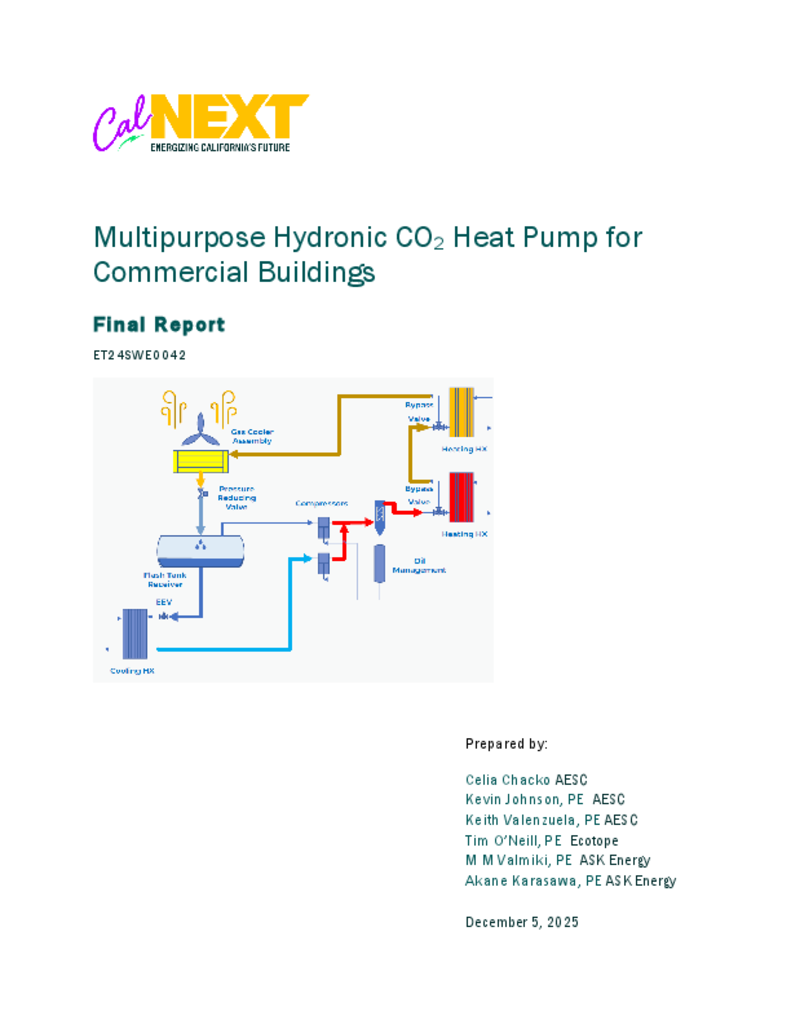ET24SWE0042 - Multipurpose Hydronic CO2 Heat Pump for Commercial Buildings
The two largest decarbonization targets in a commercial building are typically space heating and domestic hot water. Just these two end-uses account for well over 90% of the natural gas usage in most commercial buildings (excluding food service). Energy efficient, cost-effective solutions for decarbonization of these loads demand emerging technology solutions. There are economic, feasibility, and technological challenges that need to be explored and addressed through the study of early adopters and newly available products.
A newly developed, high-efficiency CO2 heat pump technology can provide space heating, space cooling, and domestic hot water. This new packaged product is commercially available in the U.S.and can produce higher temperature water than previous CO2 heat pumps which can suffice for space heating purposes. This capability enables the low-GWP heat pump to be used for multiple purposes while also replacing existing chillers used for space cooling. This aspect can preempt costly electrical and utility infrastructure upgrades by relying on the same single power service as the existing chiller while simultaneously providing heating and hot water, all with high coefficients of performance. The product is modular, can operate with high return temperatures, and high ambient temperatures – all of which are beneficial in the broadening of CO2 heat pump applications and usability.
This project will explore the design, feasibility, benefits, sizing, and cost of this product as applied to an existing building. The market potential across California will be quantified, including benefits over existing baseline incumbent alternatives. The report will outline the design considerations, how the system would integrate into the building, and provide recommendations and a roadmap for manufacturers, engineers, and utility programs. The design will inform a subsequent field demonstration in a planned follow-up study.
Space cooling, space heating, and domestic hot water (DHW) are major energy end-uses in California. Space heating and domestic hot water needs account for approximately 70 percent of natural gas use across all commercial sector buildings and over 90 percent of natural gas use in multifamily buildings, making these end-uses two of the state’s largest building decarbonization targets. Innovative technologies that are both energy-efficient and cost-effective are necessary to achieve these decarbonization targets and still satisfy demands for all three end-uses.
This study evaluated the design and feasibility of a retrofit multipurpose hydronic CO2 heat pump at one office building and one low-income multifamily building. The technology electrifies and decarbonizes heating, cooling, and DHW systems in a packaged, high- efficiency heat pump system that uses CO2, a refrigerant with low global warming potential (GWP). The project team assessed the technology at each site through site observations, design and sizing of the new system, cost evaluation methodology, building energy modeling approaches, cost proposals, and modeling results.
Both sites showed potential energy and cost savings compared to gas-fired baselines by reducing natural gas use and improving efficiency, although fuel switching increased peak electricity demand. Site 1 achieved estimated GHG emission reductions of 22 metric tons of CO2e, improved their baseline COP from 1.7 to a peak COP of 3.4, and demonstrated a Total System Benefit (TSB) of about $1,428. Site 2 had larger baseline heating loads and observed estimated GHG emissions reductions of 79 metric tons of CO2e, improved their baseline COP from 1.2 to a peak COP of 2.8, and demonstrated a TSB of about $2,259.
These findings highlight the technology’s potential to electrify and decarbonize heating, cooling, and DHW systems in commercial and multifamily buildings. Further research, including pilot demonstrations, is recommended to validate real-world performance, quantify energy impacts, and address market barriers.

